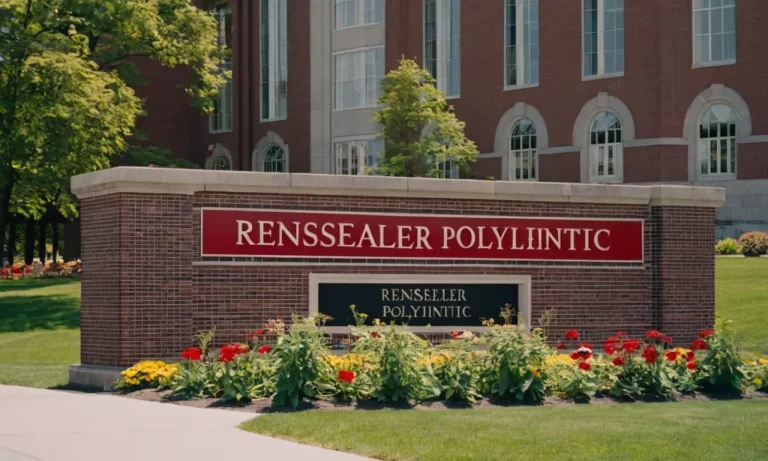When it comes to higher education, the term ‘Ivy League’ carries a certain prestige and recognition. These elite universities are known for their academic excellence, rich history, and highly selective admission processes.
If you’re considering Purdue University, you might be wondering if it falls into the prestigious Ivy League category.
If you’re short on time, here’s a quick answer to your question: No, Purdue University is not an Ivy League school.
In this comprehensive article, we’ll delve into the details of what makes a university an Ivy League institution, explore Purdue’s history and reputation, and compare it to the esteemed Ivy League schools.
We’ll also discuss the advantages and disadvantages of attending an Ivy League university versus a highly regarded public institution like Purdue.
What is the Ivy League?
Definition and History of the Ivy League
The term “Ivy League” is a prestigious collegiate athletic conference comprising eight private universities located in the Northeastern United States. The name originated from the ivy-covered brick buildings and campuses of these prestigious institutions.
The Ivy League was formed in 1954, but its history traces back to the early 1900s when a group of elite colleges formed an athletic conference. The eight universities that make up the Ivy League are Harvard, Yale, Princeton, Columbia, Brown, Dartmouth, Cornell, and the University of Pennsylvania.
The Eight Ivy League Universities
- Harvard University (founded in 1636) is the oldest institution of higher education in the United States and is renowned for its academic excellence and research prowess.
- Yale University (founded in 1701) is renowned for its prestigious law and medical schools, as well as its rich traditions and gothic architecture.
- Princeton University (founded in 1746) is consistently ranked among the top universities in the world and is known for its rigorous academics and beautiful campus.
- Columbia University (founded in 1754) is located in New York City and is renowned for its diverse student body, exceptional research facilities, and prestigious programs.
- Brown University (founded in 1764) is known for its open curriculum, which allows students to design their own course of study, and its commitment to liberal arts education.
- Dartmouth College (founded in 1769) is situated in the picturesque town of Hanover, New Hampshire, and is known for its strong sense of community and outdoor activities.
- Cornell University (founded in 1865) is a private Ivy League university and the land-grant institution of New York state, known for its exceptional programs in engineering, business, and hospitality.
- University of Pennsylvania (founded in 1740) is located in Philadelphia and is renowned for its prestigious Wharton School of Business, as well as its strong programs in medicine, law, and engineering.
Admission Requirements and Selectivity
Gaining admission to an Ivy League university is an incredibly competitive process. These institutions receive applications from the brightest and most talented students from around the world. In 2022, the acceptance rates for the Ivy League universities ranged from a mere 3.9% at Harvard to 10.9% at Cornell, with an average acceptance rate of around 6.5% across all eight schools.
😲 To stand out in the applicant pool, students typically need to demonstrate exceptional academic performance, strong test scores, impressive extracurricular activities, and compelling personal essays.
👏 The Ivy League universities are consistently ranked among the top institutions in the world, making them highly sought after and incredibly selective.
| Ivy League University | Acceptance Rate (2022) |
|---|---|
| Harvard University | 3.9% |
| Yale University | 4.5% |
| Princeton University | 4.4% |
| Columbia University | 5.8% |
| Brown University | 6.9% |
| Dartmouth College | 7.9% |
| Cornell University | 10.9% |
| University of Pennsylvania | 8.4% |
Purdue University: An Overview
Nestled in the heart of West Lafayette, Indiana, Purdue University stands as a beacon of academic excellence and innovation. With a rich history spanning over 150 years, this renowned institution has carved a niche for itself as a leading research university, consistently ranking among the top public universities in the United States.
History and Reputation of Purdue University
Founded in 1869, Purdue University’s origins can be traced back to the Morrill Land-Grant Acts, which aimed to establish educational institutions focused on agriculture, science, and engineering. Over the years, Purdue has solidified its reputation as a powerhouse in these fields, attracting students and scholars from around the globe.
According to U.S. News & World Report, Purdue ranks among the top 50 national universities and boasts a stellar reputation for its engineering and business programs. 😎
Academic Programs and Rankings
Purdue University offers a diverse array of academic programs, catering to a wide range of interests and aspirations. With over 200 majors and 69 doctoral programs, students have the opportunity to explore their passions and forge their own paths to success.
The university’s engineering programs, in particular, have garnered global recognition, consistently ranking among the top 10 in the nation according to U.S. News & World Report. Additionally, Purdue’s Krannert School of Management and College of Agriculture are highly regarded for their cutting-edge curricula and industry-relevant research.
🎓
Campus Life and Extracurricular Activities
Beyond academics, Purdue University offers a vibrant campus life brimming with opportunities for personal growth and enrichment. With over 1,000 student organizations, ranging from cultural clubs to recreational sports teams, there’s something for everyone.
The university’s athletic programs are also a source of pride, with teams competing at the highest levels of collegiate sports. Can’t you just feel the energy and excitement on game days? 🏆 Moreover, Purdue’s commitment to sustainability and environmental initiatives has earned it recognition as one of the greenest campuses in the nation, fostering a sense of responsibility and stewardship among its students.
Isn’t that awesome? 👏
Comparing Purdue to Ivy League Schools
While Purdue University is not officially designated as an Ivy League institution, it is considered a highly reputable and prestigious public research university that can be compared to Ivy League schools in several aspects.
Let’s delve into the similarities and differences between Purdue and the Ivy League universities.
Admission Selectivity and Academic Rigor
Purdue is known for its selective admission process, with an acceptance rate of around 60% for the Fall 2022 class, according to Purdue’s official news. While this rate is higher than that of Ivy League schools (typically below 10%), Purdue maintains rigorous academic standards and attracts top-performing students from across the nation and around the world.
The university’s academic programs, particularly in STEM fields like engineering and computer science, are highly regarded and on par with those offered by Ivy League institutions.
Research Opportunities and Faculty Expertise
Purdue excels in research, consistently ranking among the top universities in the United States for research expenditures. In the fiscal year 2021, Purdue’s research funding exceeded $692 million, demonstrating its commitment to advancing knowledge and innovation across various disciplines.
Like Ivy League schools, Purdue boasts a world-class faculty comprising renowned scholars, researchers, and industry experts who provide students with exceptional learning and research opportunities.
Campus Resources and Facilities
Purdue’s campus in West Lafayette, Indiana, is a vibrant and dynamic environment that rivals the facilities and resources found at Ivy League universities. The university boasts state-of-the-art laboratories, libraries, and academic buildings, as well as top-notch recreational facilities, student housing, and dining options.
Additionally, Purdue offers a wide range of student organizations, clubs, and extracurricular activities, fostering a well-rounded and enriching collegiate experience akin to that of Ivy League institutions.
While Purdue may not hold the same historical prestige as the Ivy League schools, it has consistently demonstrated its ability to provide a world-class education, cutting-edge research opportunities, and a supportive and enriching campus environment.
Many employers and graduate programs recognize Purdue’s excellence, making it a highly respected and sought-after institution for students seeking a top-tier educational experience.
Advantages and Disadvantages of Attending an Ivy League vs. Purdue
Prestige and Alumni Networks
One of the primary advantages of attending an Ivy League institution is the prestigious reputation and strong alumni networks. The Ivy League schools, which include Harvard, Yale, Princeton, Columbia, Brown, Cornell, Dartmouth, and the University of Pennsylvania, are widely regarded as among the most prestigious universities in the world.
This prestige can open doors and provide opportunities for graduates, particularly in highly competitive fields or industries. The alumni networks at these schools are also incredibly strong, with successful graduates often willing to help fellow alumni with career opportunities, mentorship, and connections.
On the other hand, Purdue University, while highly respected, does not carry the same level of prestige as the Ivy League schools. However, Purdue has a strong alumni network of its own, with over 600,000 living alumni worldwide, according to Purdue’s website.
Many of these alumni hold prominent positions in various industries and can provide valuable connections and support to fellow Boilermakers.
Cost and Financial Aid Considerations
Attending an Ivy League school can be incredibly expensive, with tuition and fees often exceeding $50,000 per year. While these schools offer generous financial aid packages, the cost can still be a significant burden for many families.
According to CollegeRaptor, the average cost of attendance for an Ivy League school in 2022-2023 was around $77,000 per year.
In contrast, Purdue University is a public institution with a much lower cost of attendance. For the 2022-2023 academic year, the estimated cost of attendance for in-state students was around $28,000, while out-of-state students paid approximately $55,000, according to Purdue’s tuition calculator.
Purdue also offers various scholarships and financial aid opportunities to help offset the cost for students.
Academic and Career Opportunities
The Ivy League schools are renowned for their academic excellence and rigorous curricula. They offer a wide range of undergraduate and graduate programs, with many opportunities for research and collaboration with world-class faculty.
Additionally, these schools often have strong relationships with top employers and can provide excellent career opportunities for graduates.
While Purdue may not have the same level of academic prestige as the Ivy League, it is still a highly respected institution with excellent academic programs, particularly in areas such as engineering, science, and technology.
Purdue has a strong emphasis on practical, hands-on learning and industry partnerships, which can be advantageous for students seeking career opportunities in these fields. According to U.S. News & World Report, Purdue is ranked among the top 20 public universities in the nation and has a reputation for producing highly skilled and employable graduates.
Conclusion
While Purdue University is not an Ivy League school, it is a highly respected public research institution with a strong academic reputation and a wide range of programs. Whether you choose to attend an Ivy League university or a top-tier public university like Purdue, the most important factor is finding the right fit for your academic goals, interests, and personal preferences.
Ultimately, the decision to attend an Ivy League school or a university like Purdue should be based on a careful evaluation of your priorities, financial considerations, and long-term career aspirations.
Both paths offer unique opportunities for personal growth, academic excellence, and future success.






